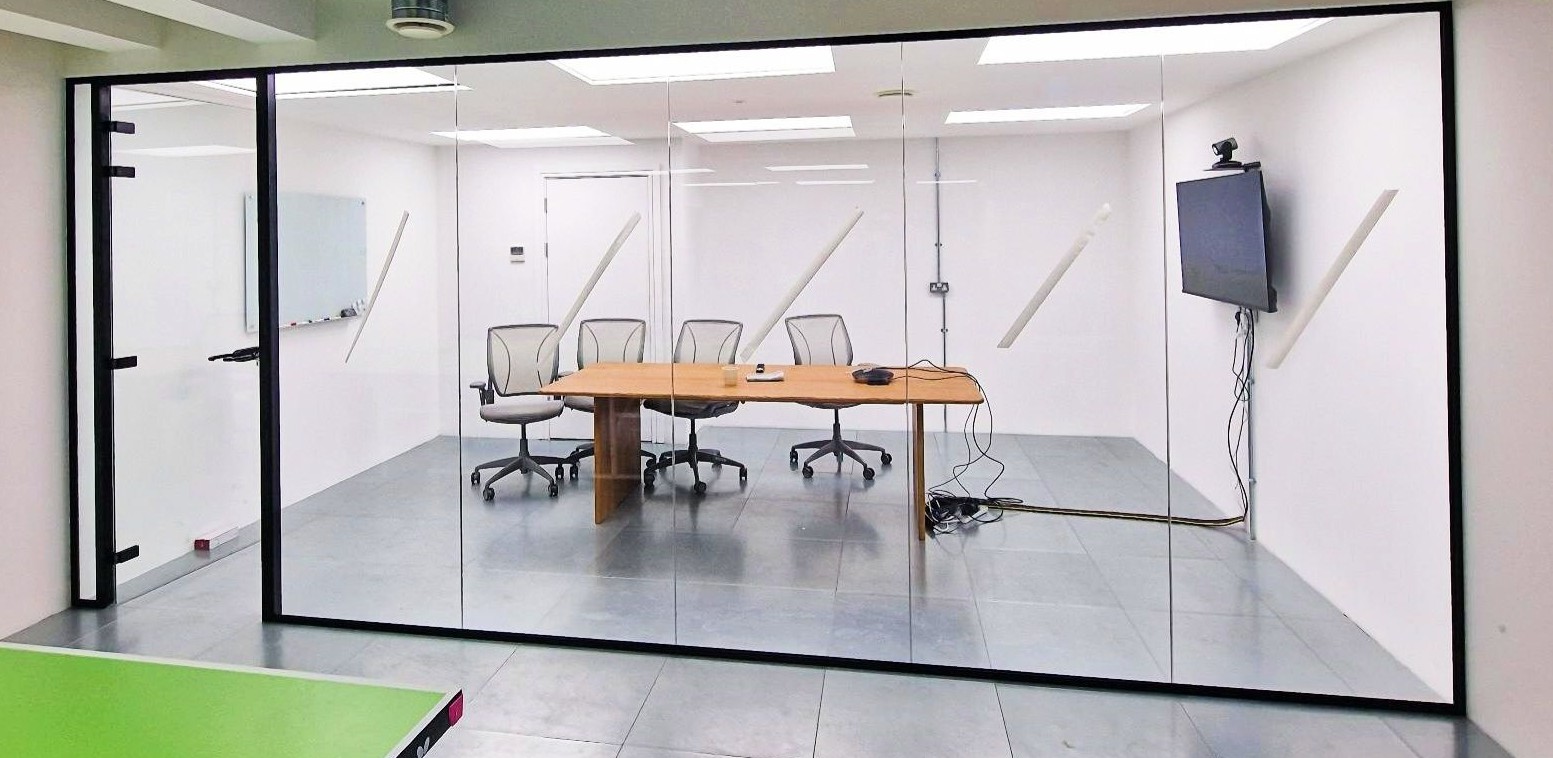
Glass partitions are now a staple in modern commercial interiors. They offer openness, light, and flexibility without compromising space division. But when it comes to choosing between black framed glass partitions and frameless glass partitions, how do you decide which is the better fit for your workspace?
This guide compares the two in terms of aesthetics, privacy, cost, installation, and maintenance, helping you make a decision based on practical needs and visual goals.
Wondering Which Glass Partition Style is Right for Your Office?
Whether you’re fitting out a creative studio, a corporate HQ, or a coworking space, the type of glass partition you choose plays a big role in your interior function and feel.
Black framed glass partitions offer an industrial, structured look, often associated with architectural detailing and vintage-inspired themes.
Frameless glass partitions, on the other hand, provide a clean, uninterrupted appearance that blends seamlessly into modern, minimal environments.
Let’s break them down to see what works best for your space.
What Are Black Framed Glass Partitions All About?
Black framed glass partitions or industrial style glass partitions feature visible aluminium or steel frames often finished in matte black surrounding each glass panel. These frames offer a structured look reminiscent of warehouse conversions or industrial-style lofts.
Commonly used in:
- Design studios
- Tech startups
- Creative offices
- Boutique coworking spaces
Benefits of Black Framed Glass Partitions
- Bold visual impact: Instantly defines zones while maintaining transparency.
- Design flexibility: Frames can incorporate internal blinds, reeded glass, or sliding doors.
- Durable and modular: Frame adds protection to edges and simplifies demounting if the layout needs to change.
- Industrial-style appeal: Complements exposed ceilings, brickwork, and timber floors.
Things to consider:
- May slightly reduce natural light compared to frameless options due to frame visibility.
- The colour and thickness of the frame must be chosen carefully to match your interior style.
What Makes Frameless Glass Partitions So Popular?
Frameless glass partitions are made from large panes of toughened or laminated safety glass that are fixed together with minimal joints and no visible frames. This style is ideal for businesses seeking a clean, contemporary look.
Typically found in:
- Executive suites
- Financial institutions
- Corporate offices
- Legal and consulting firms
Benefits of Frameless Glass Partitions
- Minimalist aesthetic: Seamless panels create an open, uncluttered look.
- Maximum light transmission: No frames to interrupt natural light flow.
- Perceived spaciousness: Ideal for smaller offices or areas where openness matters.
- Premium appeal: Often seen in high-end interior schemes.
Things to consider:
- Higher initial costs due to custom cutting and polish work.
- Requires professional installation with precise measurements and alignment.
- Less structural framing means edge protection depends on the quality of fixings.
Black Framed Glass Partitions vs. Frameless – Key Differences
To help you make the right choice, here’s a side-by-side comparison of key considerations:
1. Aesthetics
| Feature | Black Framed Glass | Frameless Glass |
| Style Appeal | Bold, industrial, defined | Sleek, modern, minimal |
| Visual Impact | Strong borders | Nearly invisible joints |
| Interior Match | Industrial, creative spaces | Corporate, luxury, minimal |
Takeaway: Choose black framed for architectural impact; choose frameless for understated sophistication.
2. Privacy & Acoustic Performance
Both types can support privacy and soundproofing through smart material choices:
Black Framed Glass:
- Can accommodate acoustic seals and thicker laminated glass.
- Easier to pair with integral blinds or double-glazed units.
Frameless Glass:
- Offers sound resistance when using acoustic glass, but requires precise sealing.
- Ideal for visual openness, but may need film or blinds for added discretion.
Tip: For privacy without sacrificing design, consider switchable smart glass or frosted films, compatible with both systems.
3. Cost Comparison
| Cost Factor | Black Framed | Frameless |
| Material Cost | Moderate | Higher (glass processing) |
| Installation Time | Faster (modular setup) | Slower (precision work) |
| Customisation | More options for modules | More complex to customise |
Pro Insight: If you’re working to a tighter budget or need to partition a large area quickly, black framed systems can be more cost-effective.
4. Maintenance & Durability
Black Framed Glass:
- Frames protect edges, reducing the risk of chipping.
- Easy to clean around panels.
- Powder-coated finishes are scratch-resistant.
Frameless Glass:
- Requires careful cleaning of joints.
- Silicone or clear joint seals may degrade over time and need resealing.
- Vulnerable edges if not handled properly.
5. Installation Considerations
Black Framed:
- Pre-engineered modules speed up installation.
- More forgiving for uneven floors or walls.
Frameless:
- Needs precision cutting and skilled installers.
- Often takes longer to complete and align correctly.
Which One Works Best for Your Office Type?
Still unsure? Here’s a quick office-type guide:
1. Creative or Industrial Workspaces: Go for black framed glass partitions for strong visual character and zoning.
2. Professional, Minimalist Offices: Choose frameless glass partitions for clean lines and uninterrupted light.
3. Hybrid Offices or Shared Spaces: Consider a combination of frameless for executive areas, black framed for breakout zones.
Final Thoughts
At the core, both black framed and frameless glass partitions serve the same function – to divide space without sacrificing openness. But they offer distinctly different design aesthetics, installation demands, and cost implications.
Choose black framed if:
- You want bold industrial aesthetics.
- Durability and modularity matter.
- You’re working with a tighter budget or timeline.
Choose frameless if:
- Your space leans toward minimalism or luxury.
- Natural light and openness are key.
- You’re investing in a long-term, high-spec design.
FAQs
Yes, the frames can be customised in various powder-coated finishes including white, grey, bronze, or even custom RAL colours.
.
Absolutely. When installed with toughened or laminated safety glass, frameless partitions meet building safety standards and are suitable for busy office environments.
Yes, integrated blinds are available for both types. Framed systems often make this easier, but frameless options can accommodate external or film-based solutions.
Acoustic laminated glass is recommended for soundproofing in both black framed and frameless systems. Double glazing further improves acoustic performance.
Framed systems are typically easier to demount and reuse. Frameless partitions can also be relocated but may require professional handling and recutting.
Yes. Black framed systems commonly integrate sliding or pivot doors. Frameless systems can use top-hung sliding glass doors for a seamless look.
Black framed partitions are slightly easier to maintain due to edge protection and fewer exposed silicone joints. Frameless systems require gentle cleaning along seals.














